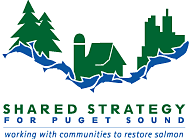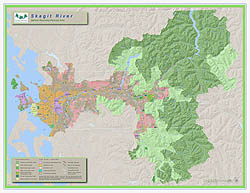 |
| |
|
|
|
|
The Skagit is the only river system in Washington which supports all five species
of salmon: Chinook, chum, Coho, pink and sockeye. It is home to six of the
region’s 22 populations of threatened Chinook salmon and the largest
population of listed bull trout. It contains the largest pink salmon stock
in Washington as well as steelhead.
|
| |
 |
Chinook
|
 |
Chum
|
 |
Coho
|
 |
Pink
|
 |
Sockeye
|
 |
Bull Trout
|
 |
Steelhead
|
| Salmon images courtesy of King County. Steelhead
image courtesy of National Oceanic and Atmospheric
Administration/Department of Commerce. |
| |
| How Chinook Use the
Watershed |
|
Adult Chinook, also called Kings because of their size--average 20 pounds in
weight, but have been recorded up to 135 pounds, and can grow to a length
of 58 inches--generally stay in the deep, fast waters of the mainstem or
large tributaries. Six of the twenty-two listed Chinook stocks in Puget Sound
are spread around the Skagit watershed: in the upper Skagit mainstem and
tributary, in the lower Skagit mainstem and tributary, in the upper and lower
Sauk, in the Suiattle and in the upper Cascade. They spend several months
to two years in the fresh water before migrating to the ocean and generally
remain in the ocean for two to four years, although some stay as long as
eight years. Their principal spawning months are from August through October.
Studies are underway to learn more about how threatened bull trout use the
watershed. |
|
|
|
 |

Salmon and the Skagit Watershed
| |
For more information about salmon recovery
planning in this watershed, visit:
Skagit Wild and Scenic River System
http://www.skagitwatershed.org
http://www.skagitcoop.org
|
 |
 |
 |
 |
 |
Key
Facts |
| |
Land use by type in the
lower portion of the watershed is 64% forestry, 22% agriculture,
5% urban, 4% range and 5% other. In the uplands, land
use is 73% forest, 12% range and 15% other.
Major cities
in the watershed include Anacortes, Burlington, Darrington,
LaConner, Mount Vernon and Newhalem.
Population growth
in Skagit County is projected at 46% between 2000 and
2020. The present population is 104,000.
The planning
area for Skagit under the state Watershed Management
Act is Watershed Resource Inventory Area (WRIA) 3 for
the lower Skagit and WRIA 4 for the upper watershed.
|
|
| |
|
The largest watershed in Puget Sound,
the Skagit system begins in Canada, flows through the rugged Cascades
down into low-lying valleys and drains into Skagit Bay. The rich
soils of the river’s
broad delta support the region’s most productive farmlands
appreciated not only for their crops of berries, potatoes and
organic vegetables, but especially renowned for their bright
fields of daffodils and tulips.
The Upper Skagit River Valley is a favored wintering area for bald
eagles. This impressive gathering of bald eagles, one of the four
largest in the contiguous 48 states, coincides with the spawning
runs of chum salmon on the Skagit River.
The upper river is home to the region’s only major complex
of dams, most of which are built above a natural barrier to salmon.
Puget Sound Energy’s two Baker dams obstructed sockeye. In
2003 19,429 adult sockeye entered the utility’s Baker River
fish-transport facility just below Lower Baker Dam, near Concrete.
Diablo, Ross and Gorge dams supply about 25 percent of Seattle’s
power demands.
Also in the Upper Skagit, the Cascade, Sauk and Suiattle rivers
are designated as Wild and Scenic, making this one of the largest
undammed river systems remaining in the Pacific Northwest. The Skagit
Wild and Scenic River designation begins just east of the town of
Sedro-Woolley, extending to Bacon Creek near the boundary of the Ross
Lake National Recreation Area in the North Cascades National Park
Service Complex. The Skagit Wild and Scenic River System includes
158.5 miles of the Skagit River and its tributaries—the Sauk,
Cascade, and Suiattle rivers.
The Skagit Delta contains large concentrations of wintering waterfowl,
shorebirds, and raptors. A significant portion of an entire Trumpeter
Swan population winters at the site, as well as the entire population
of gray-bellied brant, a subpopulation of brant geese. Birdwatchers
are known to screech on their brakes in early spring to catch the
inspiring sight of hundreds of snow geese rising off the fields in
a graceful wave and settling down again a few feet away. The estuarine
and intertidal ecosystems are critical habitat for salmon, other
marine fish which use estuaries, and wintering raptors and waterfowl.
Major Policy or Actions Needed to Recover
Salmon
Washington State, Tribal governments, the Conservation Commission’s
Limiting Factors Analysis and the Skagit Watershed Council’s
Habitat Restoration and Protection Strategy, have identified loss
of habitat in the river’s lowlands and estuary, the heart of
the watershed’s agricultural base, as one of the main causes
of Chinook declines. Diking and draining, for example, have reduced
tidal wetlands by more than 90 percent.
As a result of many factors, farmers and tribal representatives from
the Swinomish and Sauk-Suiattle tribes are meeting to find common
ground from which to approach this issue in a way that works for
both farms and fish. With high growth pressures, neither farmers
nor tribal representatives nor environmental activists want to see
these lands developed for residential or other commercial uses.
Salmon need clean, oxygen rich gravel in which to spawn. Increased
erosion and run-off from logging and roads fills gravel at the bottom
of the river with fine sediment, reducing spawning habitat. Scientists
believe that logging practices and river channelization (straightening)
contribute to increases in the amount of flooding that occurs. High
flows can destroy the redds where salmon lay their eggs. Hydrologists
are working to better understand the cause of increased peak flows
to determine what actions can be taken to reduce or prevent their
negative impacts on egg survival and on human communities. Meanwhile,
the Forest and Fish report will serve as one guide for developing
actions to address sedimentation. The Salmon Funding Recovery Board
has already funded projects to inventory logging roads and identify
priorities for closures and improvements.
Washington State, Tribal governments, the Conservation Commission’s
Limiting Factors Analysis and the Skagit Watershed Council’s
Habitat Restoration and Protection Strategy have identified loss
of riparian corridors in the Skagit basin as a key factor limiting
salmon recovery. 42% of the river channels supporting salmon would
benefit from riparian restoration. Healthy riparian zones consist
of a mix of trees, bushes and ground covers that provide insect larvae
from leaf droppings, shade to keep the water cool, prevent stream
bank erosion and filter sediment, and reduce flow rates during flood
events. Over time, riparian areas also provide woody debris that
falls into the river forming pools in which salmon can rest and hide
from predators. Groups of local volunteers, as part of the HB 2496
program coordinated by the Skagit Watershed Council and its members,
have been working to plant trees and bushes to restore these buffers
for quite some time on both public and private property.
| We’re
Making Progress—Some Accomplishments |
Voluntary Projects Are Going
Strong
Recovery efforts in the upper watershed are well underway
and have enjoyed significant progress. As members of the
Skagit Watershed Council, local governments, citizens and
community groups have taken action to restore streamside
vegetation and improve fish passage along the Skagit and
its major tributaries and have prioritized and implemented
additional projects based on science and the potential
for collaborative action.
Estuary Restoration
Ten years in the making, the Deepwater Slough Project
in the South Fork of the Skagit removed two main
dikes on state land. This allowed the mainstem and
six tributary channels to re-connect and return to
their historic paths and restored 200 acres of estuary
habitat. The project is expected to produce an additional
1,000 to 2,000 adult Chinook and continues to support
important migratory waterfowl and shorebird habitat.
A First in Washington State
In affirmation of Seattle City Light’s commitment
to salmon recovery, the utility’s Skagit dam complex
recently became the first hydroelectric project in the
state to receive low-impact hydropower certification from
an independent non-profit certification group that includes
American Rivers and other conservation organizations. Seattle
City Light, which owns and operates the major dams on the
upper Skagit, maintains its strong commitment to putting “fish
first.” The utility and its customers regularly forgo
some power production to ensure appropriate flows for spawning
salmon.
|
|
Organizations Involved
- City of Mount Vernon
- Samish Indian Nation
- Crown Pacific
- Seattle City Light
- Ducks Unlimited
- Skagit Audubon Society
- Earthwatch Institute
- Skagit Conservation District
- Fidalgo Fly Fishers
- Skagit County
- Huxley College of the Environment
- Skagit County Farm Bureau
- Long Live the Kings
- Skagit County Marine Resources Committee
- Longview Fibre Company
- Skagit Fisheries Enhancement Group
- Mount Baker-Snoqualmie National Forest
- Skagit Land Trust
- National Wildlife Federation
- Skagit River System Cooperative
- Natural Resources Conservation Service
- Skagit Valley College
- North Cascades Institute
- Skagitonians to Preserve Farmland
- North Cascades National Park
- The Nature Conservancy
- Padilla Bay Foundation
- Upper Skagit Indian Tribe
- Padilla Bay National Estuarine Research Reserve
- WA Department of Ecology
- People for Puget Sound
- WA Department of Fish and Wildlife
- Public Utility District #1 of Skagit County
- WA Department of Natural Resources
- Puget Sound Action Team
- WA State University Cooperative Extension
- Puget Sound Anglers - Fidalgo Chapter
- Western WA Agricultural Association
- Puget Sound Energy
- Wildcat Steelhead Club
Back to Top | Back
to Watershed Profiles
|


